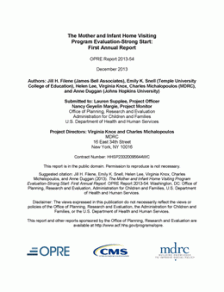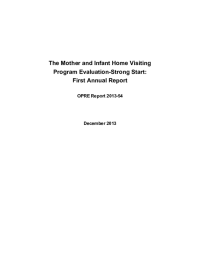First Annual Report from the Mother and Infant Home Visiting Program Evaluation-Strong Start

Improving birth, infant, and maternal health outcomes, particularly among socio-economically disadvantaged families, is an important health goal of the nation. Home visiting services have been identified by the Strong Start for Mothers and Newborns (Strong Start) initiative of the Centers for Medicare and Medicaid Services (CMS) as one promising method for reaching pregnant women who are vulnerable to poor health outcomes.
This report introduces the Mother and Infant Home Visiting Program Evaluation-Strong Start (MIHOPE-Strong Start), which was designed by CMS and the Administration for Children and Families (ACF), is funded by CMS, and is being implemented in partnership with the Health Resources and Services Administration (HRSA). The study is designed to assess the impacts of evidence-based home visiting programs for disadvantaged expectant mothers. MIHOPE-Strong Start uses a rigorous random assignment design to examine the effects of home visiting programs on birth outcomes and maternal and infant health and health care. The study will also examine rich information on local implementation processes. The study is being conducted by MDRC in partnership with James Bell Associates, Johns Hopkins University, and Mathematica Policy Research.
Local programs included in the evaluation will use one of two national home visiting models that have shown previous evidence of improving birth outcomes: Healthy Families America (HFA) and Nurse-Family Partnership (NFP). Local program implementation is guided by the direction of the national model developers (HFA and NFP) through the articulation of their service models, including their focus on particular outcomes and families and their guidelines regarding dosage and delivery of services. A detailed description of the two models, including their similarities and differences, is included in this report and can be summarized as follows:
- Both national models serve low-income, pregnant women over a period of multiple years. However, a significant proportion of HFA participants enroll after they have given birth rather than before, whereas NFP enrolls only first-time pregnant women. These differences in targeting strategies are consistent with the particularly high priority that HFA places on preventing child abuse and neglect, whereas NFP places very high priority on improving birth and maternal and infant health outcomes (as well as other family outcomes).
- There are also important differences across the two national models in the flexibility and structure that they provide to local programs in areas of program implementation, such as staffing requirements, timing of enrollment, and services delivered. HFA asks implementing agencies to follow a set of program principles but then allows local agencies to tailor operational decisions. NFP has a more highly defined and structured approach and expects local programs to strive for fidelity to the service model as it has been defined at the national level.
Future reports will examine how home visiting services are provided and the effects that the programs have on birth outcomes and on maternal and infant health and health care use.






